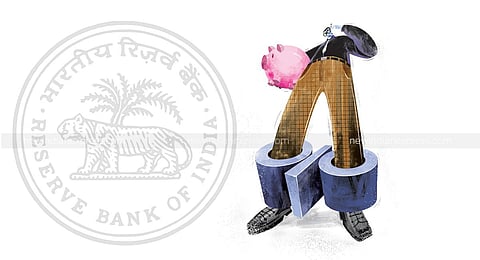

The RBI's inflation-axing sword is back in its sheathe, with the central bank keeping repo rate unchanged at 6.5 per cent on Thursday.
But rate hikes aren't completely off the table with Governor Shaktikanta Das explicitly announcing, twice, that Thursday's decision to pause was limited to the April meeting alone.
It means, the Monetary Policy Committee (MPC) is simply taking five after a breathless run of six consecutive rate hikes. Its suit of armour to engage in a battle against inflation remains intact and as Das stressed, the central bank's job was not yet finished until we see a durable decline in inflation closer to the 4 per cent target. For emphasis, he invoked Kautilya, quoting: Be not slack before the whole job is finished.
The surprise decision to pause was also accompanied by a status quo on policy stance to remain with 'withdrawal of accommodation,' as against market expectations of shifting to a neutral stance. Such a move would have confirmed a decisive pause on rate hikes, but that's not the case for now.
Since the monetary policy tightening cycle began last May, RBI has cumulatively raised the repo rate by 250 bps from 4 per cent to 6.5 per cent, a level last seen in 2019. Along with the February 2022's standing deposit facility rate of 40 bps above the repo rate, the effective rate hike stands at 290 bps, implying that the real rates are well above 1.5 per cent, considering the one-year forward inflation forecast as the anchor.
Usually, a rate hike confirms rising inflation, while a pause indicates likely moderation in price rise. But Thursday's 'hawkish pause' sends no such clear signals, because no one seems to be sure if inflation is coming or going.
As Das noted, global inflation is moderating, but he quickly reminded us about the volatile times. The recent, unexpected decision by OPEC on production output cuts spurred oil prices only complicated the inflation outlook, adding to prevailing uncertainties.
Back home, headline inflation has softened, but disinflation is likely to be gradual and protracted, given the rigidity in core or underlying inflation pressures. For FY23, RBI projects headline inflation to moderate to 5.2 per cent, with Q1 at 5.1 per cent, Q2 at 5.4 per cent, Q3 at 5.4 per cent, and Q4 at 5.2 per cent.
That said, the central bank will likely miss its Q4, FY23 inflation forecast of 5.6 per cent. Official numbers for January and February stood at 6.52 per cent and 6.44 per cent respectively and March print must come under 5 per cent for RBI's forecast to stand. But analysts expect it to be around or under 6 per cent and not 5 per cent. The MPC even missed its December quarter CPI estimates with Q3 headline inflation printing at 6.1 per cent as against the central bank's estimate of 6.6 per cent. So in all likelihood, RBI will likely miss the full fiscal FY23 inflation estimate of 6.5 per cent as well.
As for growth, it pegged FY24 real GDP growth at 6.5 per cent, with Q1 at 7.8 per cent, Q2 at 6.2 per cent, Q3 at 6.1 per cent, and Q4 at 5.9 per cent with risks evenly balanced.
Given real policy rates of upwards of 1 per cent, any further rate hikes coupled with elevated prices could potentially dampen the purchasing power of consumers and curtail demand. Over the past three quarters, interest rates on home loans have shot up to over 9 per cent, representing a 40-50 per cent increase from the historical low of 6.5 per cent per annum. Borrowers are feeling the impact and any further hikes could push the home loan interest rate beyond the psychological barrier of 10 per cent, which could have a substantial impact on buyer sentiments and affordability.
Towards the end of 2023, global central banks rate hike race seemingly reached the last lap. Ironically, the finish line is nowhere to be seen and the so-called pivot, when central banks' reverse their rate hike decisions to rate cuts (and vice versa), continues to live its life as a teaser for over two quarters now. If Bank Indonesia Governor Perry Warjiyo termed "this is a time of sleepless nights,' Bank of England's chief economist Huw Pill believes inflation as a manifestation of ‘bad luck.'
And as Das channeled Alan Greenspan, 'Uncertainty is the defining characteristic of the monetary policy landscape,' the evolution of monetary policy from hereon will be keenly watched.
READ MORE: